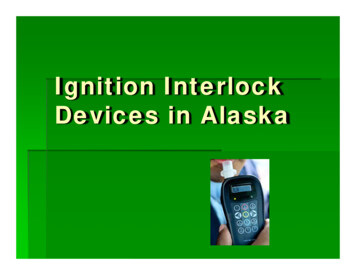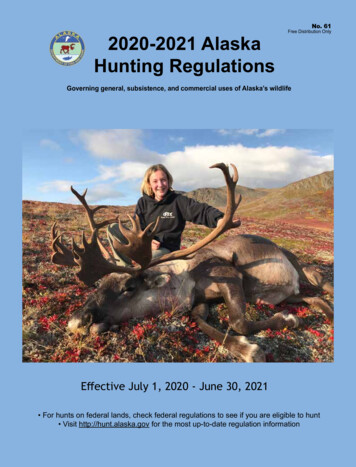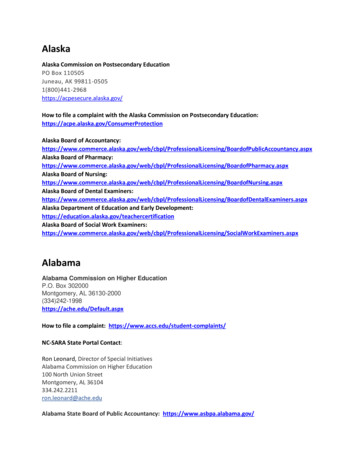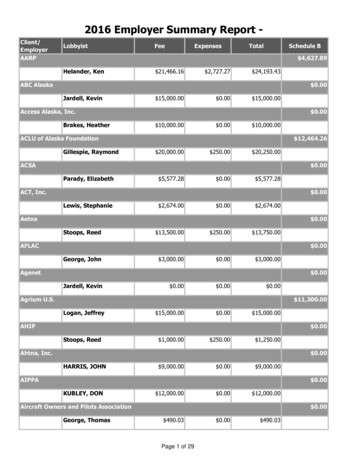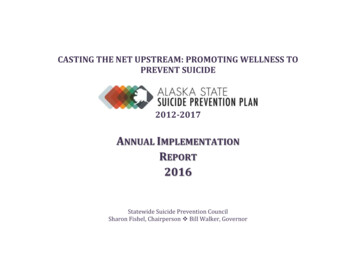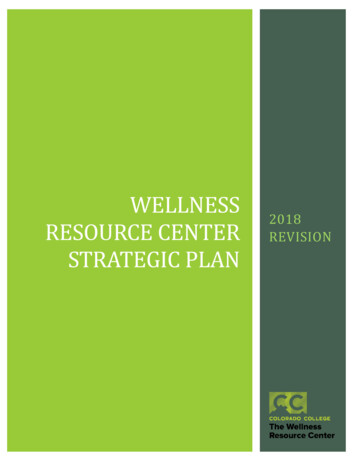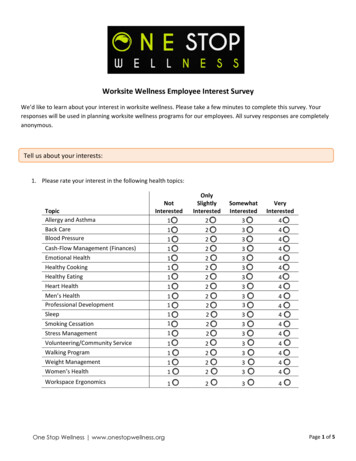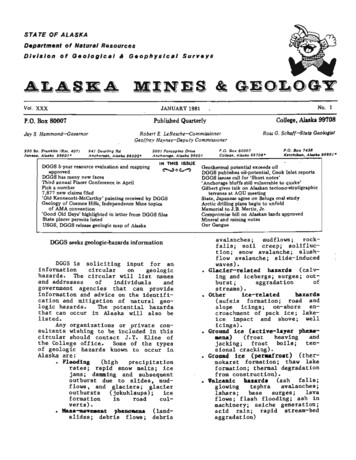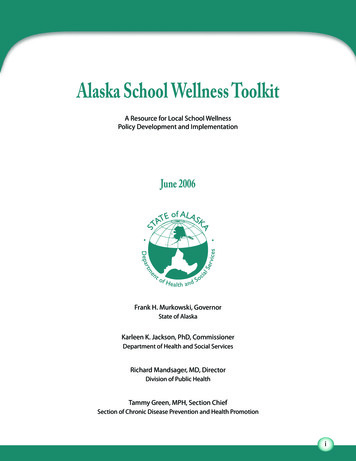
Transcription
Alaska School Wellness ToolkitA Resource for Local School WellnessPolicy Development and ImplementationJune 2006Frank H. Murkowski, GovernorState of AlaskaKarleen K. Jackson, PhD, CommissionerDepartment of Health and Social ServicesRichard Mandsager, MD, DirectorDivision of Public HealthTammy Green, MPH, Section ChiefSection of Chronic Disease Prevention and Health Promotion
Suggested Citation:Peterson E, Fink K, Stevens R, Alaska School Wellness Toolkit. Anchorage, AK: Section of ChronicDisease Prevention and Health Promotion, Division of Public Health, Alaska Department of Health andSocial Services, 2006.All material in this document is in the public domain and may be reproduced or copied withoutpermission.AcknowledgementsThis toolkit was developed by the Alaska Department of Health and Social Services, Division of PublicHealth, Section of Chronic Disease Prevention and Health Promotion. It was produced with supportfrom the United States Department of Agriculture, Food and Nutrition Services, Team Nutrition Grantthrough an agreement with the Alaska Department of Education & Early Development.The toolkit was prepared by:Erin Peterson, MPHKarol Fink, MS, RDRuss StevensPatty Owen, CHESAndrea Fenaughty, PhDWe would like to thank the following reviewers:Todd Brocious, Education SpecialistAlaska Department of Education & Early DevelopmentTerri Campbell, Education SpecialistAlaska Department of Education & Early DevelopmentNancy Copping, Region Vice PresidentAlaska Parent Teacher AssociationStacy Goade, Program Manager, Child Nutrition ServicesAlaska Department of Education & Early DevelopmentJanelle Gomez, MS, RD, WIC and Community NutritionistDepartment of Health and Social ServicesMary Grisco, Past ChairAlaska Action for Healthy Kidsii
Dean Hamburg, School Nutrition Services CoordinatorKenai Peninsula Borough School DistrictMollie Langum, School Program DirectorWashington State Dairy CouncilJulie McWilliams, Education SpecialistLower Kuskokwim School DistrictTia Patterson, School/Community CoordinatorSteps to a Healthier Southeast AlaskaSoutheast Alaska Regional Health ConsortiumKimberly StrykerDepartment of Environmental ConservationJennifer Schmidt, Board MemberFairbanks Northstar Borough School DistrictSharon Vaissiere, Health and PE Curriculum CoordinatorAnchorage School DistrictTim Wallstrom, PhD, Past ChairAlaskans Promoting Physical ActivityKathleen Wayne, MS, RD, Family Nutrition Program ManagerDepartment of Health and Social ServicesEvelyn Williams, Community Wellness AdvocateSteps to a Healthier Southeast AlaskaSoutheast Alaska Regional Health CorporationSharon Young, Associate Executive DirectorAssociation of Alaska School BoardsFor more information or additional copies contact:Department of Health and Social ServicesDivision of Public HealthSection of Chronic Disease Prevention and Health PromotionPO Box 240249Anchorage, AK 99524-0249Phone: 907-269-8126Email: cdphp@health.state.ak.usWeb: www.hss.state.ak.us/dph/chronic/iii
Table of ContentsSection I: Introduction to Local School Wellness Policies 1Introduction to Local School Wellness Policies3Toolkit Organization . . . . . . . . . . . . . . . . . . . . . . . . . . . . . . . . . . . . . . . . . . . . . . . 4Why Implement a Local School Wellness Policy? 5Section II: Tools for Compliance: Association of Alaska School Boards SamplePolicy Materials. . . . . . . . . . . . . . . . . . . . . . . . . . . . . . . . . . . . . . . . . . . . . . . . . . . . 7Association of Alaska School Boards Sample Policy . . . . . . . . . . . . . . . . . . . . . . . . . . . . 9Association of Alaska School Boards Sample Administrative Regulations . . . . . . . . . . . . . 11Association of Alaska School Boards Exhibit: Federal Reauthorization Language . . . . . . . . . . 14Section III: Tools for Local School Wellness Policy Development . . . . . . . . . . . . . . . . . . . . . . . . 15Overview of Local School Wellness Policy Development Tools . . . . . . . . . . . . . . . . . . . . . 17What to Consider when Developing a Local School Wellness Policy . . . . . . . . . . . . . . . . . 18Creating a Policy Development Team . . . . . . . . . . . . . . . . . . . . . . . . . . . . . . . 18Role of Schools in Promoting Physical Activity and Nutrition . . . . . . . . . . . . . . . . . 18Establishing a Commitment to Local School Wellness Policies . . . . . . . . . . . . . . . . 18Policy Content . . . . . . . . . . . . . . . . . . . . . . . . . . . . . . . . . . . . . . . . . . . . . . 19Policy Implementation . . . . . . . . . . . . . . . . . . . . . . . . . . . . . . . . . . . . . . . . . 19Planning and Periodic Review . . . . . . . . . . . . . . . . . . . . . . . . . . . . . . . . . . . . 19Communication with Parents . . . . . . . . . . . . . . . . . . . . . . . . . . . . . . . . . . . . . 20Component 1: Nutrition Guidelines for All Foods Available in Schools . . . . . . . . . . . . . . . 21Introduction to Nutrition Guidelines . . . . . . . . . . . . . . . . . . . . . . . . . . . . . . . . 21Food and Beverage Standards . . . . . . . . . . . . . . . . . . . . . . . . . . . . . . . . . . . . 22Food and Beverages Sold During the School Day . . . . . . . . . . . . . . . . . . . . . . . . 26Food and Beverages Served During the School Day . . . . . . . . . . . . . . . . . . . . . . 28Food and Beverages Served and Sold Outside of the School Day . . . . . . . . . . . . . . 28Providing and Promoting Healthier Food and Beverage Choices . . . . . . . . . . . . . . 31Providing Nutritious and Appealing Food and Beverages . . . . . . . . . . . . . . . 31Schedule of Meals and Meal Environment . . . . . . . . . . . . . . . . . . . . . . . . 31Promoting 1% (Lowfat) and Non-Fat Milk . . . . . . . . . . . . . . . . . . . . . . . . 33Promoting Fruits and Vegetables . . . . . . . . . . . . . . . . . . . . . . . . . . . . . . 34Promoting Alaska Grown and Produced . . . . . . . . . . . . . . . . . . . . . . . . . . 34Marketing of Food and Beverages . . . . . . . . . . . . . . . . . . . . . . . . . . . . . 35Food and Beverages as Punishment or Reward . . . . . . . . . . . . . . . . . . . . . 36iv
Component 2: Assurances that guidelines for reimbursable school mealsare not less restrictive than federal requirements 37Assurances that School Meal Guidelines Meet Federal Requirements . . . . . . . . . . . 37Reimbursable School Meal Programs . . . . . . . . . . . . . . . . . . . . . . . . . . . . . . . . 38National School Lunch, School Breakfast, Severe Need Breakfast,Special Milk, and After School Snack Programs . . . . . . . . . . . . . . . . 38School Meals Initiative for Healthy Children . . . . . . . . . . . . . . . . . . . . . . . 38Participation in School Meal Programs . . . . . . . . . . . . . . . . . . . . . . . . . . . 39Protecting Confidentiality of Free/ Reduced Meal Participants . . . . . . . . . . . 40Component 3: Goals for Nutrition Education41Nutrition Education . . . . . . . . . . . . . . . . . . . . . . . . . . . . . . . . . . . . . . . . . . . 41Component 4: Goals for Physical Activity . . . . . . . . . . . . . . . . . . . . . . . . . . . . . . . . . . 42Introduction to Physical Activity . . . . . . . . . . . . . . . . . . . . . . . . . . . . . . . . . . . 42School Site Selection . . . . . . . . . . . . . . . . . . . . . . . . . . . . . . . . . . . . . . . . . . 43Physical Activity Before School . . . . . . . . . . . . . . . . . . . . . . . . . . . . . . . . . . . . 43Physical Activity During the School Day . . . . . . . . . . . . . . . . . . . . . . . . . . . . . . 44Education on the Benefits of Physical Activity . . . . . . . . . . . . . . . . . . . . . . 44Physical Education Curriculum . . . . . . . . . . . . . . . . . . . . . . . . . . . . . . . . 45Recess . . . . . . . . . . . . . . . . . . . . . . . . . . . . . . . . . . . . . . . . . . . . . . . 48Classroom-based Physical Activity . . . . . . . . . . . . . . . . . . . . . . . . . . . . . 49Physical Activity as Punishment . . . . . . . . . . . . . . . . . . . . . . . . . . . . . . . 50Physical Activity After School . . . . . . . . . . . . . . . . . . . . . . . . . . . . . . . . . . . . . 50Other Considerations for Promoting Physical Activity in Schools . . . . . . . . . . . . . . 51Walking Programs . . . . . . . . . . . . . . . . . . . . . . . . . . . . . . . . . . . . . . . . 51Special Events . . . . . . . . . . . . . . . . . . . . . . . . . . . . . . . . . . . . . . . . . . . 51School Infrastructure . . . . . . . . . . . . . . . . . . . . . . . . . . . . . . . . . . . . . . 52Component 5: Other Activities Designed to Promote Student Wellness . . . . . . . . . . . . . . 53Coordinated School Health Program . . . . . . . . . . . . . . . . . . . . . . . . . . . . . . . . 53Health Education . . . . . . . . . . . . . . . . . . . . . . . . . . . . . . . . . . . . . . . . . 54Health Promotion for Staff . . . . . . . . . . . . . . . . . . . . . . . . . . . . . . . . . . . 54Component 6: Monitoring, Compliance, and Evaluation . . . . . . . . . . . . . . . . . . . . . . . . 55References . . . . . . . . . . . . . . . . . . . . . . . . . . . . . . . . . . . . . . . . . . . . . . . . . . . . . . 57Section IV: Tools for Local School Wellness Policy Implementation . . . . . . . . . . . . . . . . . . . . . . 59Materials for Policy Development Teams . . . . . . . . . . . . . . . . . . . . . . . . . . . . . . . . . . 59Sample Nutrition Policy Implementation Timeline . . . . . . . . . . . . . . . . . . . . . . . 61
Sample Physical Activity Policy Implementation Timeline . . . . . . . . . . . . . . . . . . . 62Materials for Board Members . . . . . . . . . . . . . . . . . . . . . . . . . . . . . . . . . . . . . . . . . 63Board Resolution . . . . . . . . . . . . . . . . . . . . . . . . . . . . . . . . . . . . . . . . . . . . 65Materials for Administrators . . . . . . . . . . . . . . . . . . . . . . . . . . . . . . . . . . . . . . . . . . 67Sample Letter to Parents . . . . . . . . . . . . . . . . . . . . . . . . . . . . . . . . . . . . . . . . 69Traditional Foods in School . . . . . . . . . . . . . . . . . . . . . . . . . . . . . . . . . . . . . . 71The Alliance for a Healthier Generation Beverage Agreement . . . . . . . . . . . . . . . . 73Materials for Parents . . . . . . . . . . . . . . . . . . . . . . . . . . . . . . . . . . . . . . . . . . . . . . . 75Lunchbox Makeovers . . . . . . . . . . . . . . . . . . . . . . . . . . . . . . . . . . . . . . . . . . 77Family Meals . . . . . . . . . . . . . . . . . . . . . . . . . . . . . . . . . . . . . . . . . . . . . . . 79Physical Activity Tips for Parents . . . . . . . . . . . . . . . . . . . . . . . . . . . . . . . . . . . 80Materials for School Staff . . . . . . . . . . . . . . . . . . . . . . . . . . . . . . . . . . . . . . . . . . . . 81Alternatives to Using Food as a Reward . . . . . . . . . . . . . . . . . . . . . . . . . . . . . . 83Materials for School Events . . . . . . . . . . . . . . . . . . . . . . . . . . . . . . . . . . . . . . . . . . . 85Healthy Celebrations . . . . . . . . . . . . . . . . . . . . . . . . . . . . . . . . . . . . . . . . . . 87Fundraising Events . . . . . . . . . . . . . . . . . . . . . . . . . . . . . . . . . . . . . . . . . . . 89Fundraising Sale Ideas . . . . . . . . . . . . . . . . . . . . . . . . . . . . . . . . . . . . . . . . . 91Section V: Resource List and Glossary . . . . . . . . . . . . . . . . . . . . . . . . . . . . . . . . . . . . . . . . . 93Toolkit Resources . . . . . . . . . . . . . . . . . . . . . . . . . . . . . . . . . . . . . . . . . . . . . . . . . 95Materials and Resources . . . . . . . . . . . . . . . . . . . . . . . . . . . . . . . . . . . . . . . . . . . . . 99Glossary. . . . . . . . . . . . . . . . . . . . . . . . . . . . . . . . . . . . . . . . . . . . . . . . . . . 105Notes Page . . . . . . . . . . . . . . . . . . . . . . . . . . . . . . . . . . . . . . . . . . . . . . . . . . . 110vi
Section IIntroduction to LocalSchool Wellness Policies
Section I: IntroductionIntroduction to Local SchoolWellness PoliciesIn June, 2004, Congress passed Public Law108-265, the Child Nutrition and WICReauthorization Act of 2004. Section 204 ofthis law requires all local education agenciesparticipating in a program authorized bythe Richard B. Russell National School LunchAct or the Child Nutrition Act of 1966 toestablish a local school wellness policy bythe start of the 2006-2007 school year. Acopy of the reauthorization language can befound on page 14 of this document.The reauthorization act requires thatparents, students, representatives of theschool food authority, the school board,school administrators, and the public beinvolved in the development of the wellnesspolicy. The law also states that the policydeveloped must address the following sixcomponents:Component 1: Nutrition Guidelines for AllFoods Available at SchoolComponent 2: Assurances that School MealGuidelines are Not Less Restrictive thanFederal RequirementsComponent 3: Goals for NutritionEducationComponent 4: Goals for Physical ActivityComponent 5: Goals for Other Schoolbased Activities Designed to PromoteStudent WellnessComponent 6: A Plan for Monitoring PolicyImplementationSeveral groups in Alaska have createdresources that school districts can use todevelop and implement their local schoolwellness policies. The Association of AlaskaSchool Boards (AASB), in collaborationwith the State of Alaska Department ofEducation & Early Development, and theState of Alaska Section of Chronic DiseasePrevention and Health Promotion, hasdeveloped a sample policy and set ofadministrative regulations around the topicof Student Nutrition and Physical Activity(Board Policy 5040). The sample policyand the accompanying regulations are notrequirements for districts. Rather, theyare meant to serve as examples of policylanguage that districts can modify or tailorto fit their own circumstances. Schooldistricts that are AASB members received acopy of the sample policy language in thePolicy Reference Manual update distributedin January. A copy of the policy was alsosent to non-member districts in the state.The sample policy language is available onthe AASB website at:www.aasb.org/Frontpage/Feature2.htmland a copy of the sample policy is includedin Section II (page 9) of this toolkit.To supplement the sample policy languageand administrative regulations providedby the AASB, the State of Alaska Sectionof Chronic Disease Prevention and HealthPromotion has developed this schoolwellness toolkit. The toolkit containsinformation on why wellness policies areimportant and the role that schools canplay in promoting physical activity andgood nutrition among students. The toolkitalso provides suggestions on topics thatshould be covered by the local wellnesspolicy and on steps that can be taken todevelop a policy. As is the case with thesample policy language and administrativeregulations developed by the Associationof Alaska School Boards, this toolkit doesnot contain additional mandates orrequirements for school districts. Rather,the toolkit is designed to serve as a resourcefor groups working on local school wellnesspolicy development and for schools thatimplement policy changes.
Section I: IntroductionToolkit OrganizationThe toolkit is divided into five sections. Abrief description of each section follows.Section I: Introduction to Local SchoolWellness PoliciesThe first section is designed for use byboard members, administrators, and policydevelopment team members. It containsa brief description of the requirementsof the 2004 Child Nutrition and WICReauthorization Act, as well as backgroundinformation on why local school wellnesspolicies are important.Section II: Tools for ComplianceSection II contains a copy of the samplematerials developed by the AASB, theState of Alaska Department of Education& Early Childhood Development, and theState of Alaska Section of Chronic DiseasePrevention and Health Promotion. Districtsthat adopt these materials will meet thelegal requirements of the reauthorizationact.Section III: Tools for Local SchoolWellness Policy DevelopmentFor districts wishing to implementadditional nutrition and physical activitypolicy changes, Section III provides moredetailed information on each of thewellness policy components. Section III isalso designed for use by board members,administrators, and policy developmentteams. It contains additional optionalpolicy language that is informed by oradapted from national authorities, includingthe National Alliance for Nutrition andActivity (NANA), the National Associationfor Sport and Physical Education (NASPE),the National Association of State Boardsof Education (NASBE), and the Alliancefor a Healthier Generation. The optionallanguage is designed to give local districtsan example of policy changes beingconsidered in other states and to stimulate discussion on appropriate local policy. Itdoes not reflect a state policy or imposeadditional requirements on local districts.Suggestions on how policy changes couldbe implemented are also included for eachtopic. Once districts develop a schoolwellness policy, numerous groups will likelybe involved in implementing it.Section IV: Tools for Local SchoolWellness Policy ImplementationSection IV of the toolkit contains resourcematerials that could be used for referenceor distributed to a variety of audiences,including parents, teachers, administrators,and others in positions to promote studenthealth and well-being.Section V: Resource List and GlossarySection V contains a list of additionalnational, state, and local resources thatindividuals involved in policy developmentcan draw upon to design and implementlocal wellness policies. It also contains aglossary of terms used in the document.
Section I: IntroductionWhy implement a local schoolwellness policy?The national focus on local school wellnesspolicy development is linked to thedramatic increase in childhood overweightobserved in the United States over thepast several decades. Since the 1970’s thepercentage of overweight children ages2-5 and adolescents 12-19 has doubled.In the same time period the prevalenceof overweight has tripled among childrenages 6-11.1 In Alaska data from the 2003Youth Risk Behavior Survey (YRBS) indicatethat 29% of male high school studentsand 21% of female high school studentsare overweight or at-risk for becomingoverweight.2The health consequences of childhoodoverweight are serious. High bloodpressure, high cholesterol, orthopedicdisorders, type 2 diabetes, and psychosocialdisorders are more common amongoverweight youth than among thosewith a healthy body weight. Currentlyan estimated 60% of overweight childrenages 5-10 have at least one risk factor forcardiovascular disease, and a quarter havetwo or more risk factors.3 Overweightyouth often carry excess weight intoadulthood and are subsequently at riskfor numerous chronic health conditions.4For example, 30% of boys and 40% ofgirls born in the year 2000 are expectedto develop diabetes in their lifetime.5 Ifcurrent trends in overweight are notreversed today’s generation of childrencould be the first to live shorter lives thantheir parents.6For most children, overweight can beprevented by balancing a healthy dietwith physical activity. Unfortunately, toomany Alaskan children today are unableto maintain that balance. Only 20% ofAlaskan high school girls and 23% of highschool boys consume the recommendedfive or more servings of fruits andvegetables each day. Many Alaskan highschool students also get less physical activitythan is recommended. Between 1995 and2003 the percentage of Alaskan high schoolstudents who participated in vigorousphysical activity declined. In addition, overone-quarter (27%) of high school studentsdid not meet the Centers for DiseaseControl and Prevention (CDC) minimumrecommendations for physical activity in2003.2If we are to improve physical activity andnutrition behaviors among Alaskan childrenand reduce overweight we must ensurethat children know the importance of goodnutrition and physical activity and that theyhave opportunities to be active and eat well.A 2004 study of childhood overweight inthe Anchorage School District illustratesthe fact that schools should not be heldresponsible for the epidemic of childhoodoverweight, nor should they be expected tosolve the problem alone. In the study, thepercentage of students entering school ata weight above what is considered normalwas nearly as high as the percentage ofoverweight and risk for overweight amongstudents in all grades. Over a five year timeperiod (1998-2003), 36% of all studentswere overweight or at-risk for becomingoverweight. In that same time period,thirty-two percent of kindergarten and firstgrade students were overweight or at-risk.7Clearly parents, community members,health care providers, and others must beinvolved in efforts to ensure that studentsenter school at a healthy weight andmaintain a healthy weight over time.Schools can play an important role inhelping students balance their calorie intakeand expenditures, however, by activelypromoting good nutrition and physicalactivity. The United States Department ofHealth and Human Services notes that, nextto families, the school has more influenceon the lives of young people than anyother social institution.8 Schools can usethat influence to promote positive healthbehaviors by providing education on goodnutrition and physical activity.
Section I: IntroductionMore importantly, schools can give childrenopportunities to practice the healthybehaviors they learn about in class. Schoolscan ensure that the meals and snacksoffered to children are nutritious. Theycan provide physical education courses,and give children other opportunities tobe active during the school day. Onemechanism for supporting school-basednutrition and physical activity is to developa strong school wellness policy.Description of Terms:The term “policy”can be interpreted indifferent ways. In manyschool districts, a policy is a generalstatement of goals. Details on how toimplement a policy are often writtenup separately as a set of administrativeregulations. Section II of this toolkitcontains sample policy language andsample administrative regulations. Inthe remainder of the toolkit, the term“wellness policy” is used to describeboth the policy statement and anyadministrative regulations thataccompany it.Developing and implementing acomprehensive local school wellness policycan be a daunting task. Schools have manyresponsibilities and are under pressure tomeet increasingly strict academic standards.In a climate where schools must improvetest scores or risk funding losses it is oftenhard to make physical activity and nutritiona priority. In many cases, supportingphysical activity and good nutrition can bechallenging from an economic standpoint.Desirable foods such as fresh fruits andvegetables can be more costly to procureand prepare than pre-packaged, but lessnutritious alternatives. In the absenceof adequate funding from other sources,many schools have also come to depend onthe revenue from sales of unhealthy foodsto fund sports teams or extracurricularactivities. In addition, it is expensive tobuild and maintain facilities for physicalactivity, and Alaskan weather can limitoutdoor activities. Schools have the potentialand a responsibility to helpchildren develop the skills,knowledge, and confidencenecessary to adopt and maintain ahealthy lifestyle.While schools face numerous challengesin promoting nutrition and physicalactivity it is critical that efforts to create ahealthy school environment are made. Bypromoting healthy behavior, schools canincrease student’s capacity to learn, reduceabsences, and improve physical fitness andmental alertness. In turn, this helps youngpeople acquire the knowledge and skills tobecome healthy and productive adults.
Section IITools for ComplianceAssociation of AlaskaSchool Boards SamplePolicy Materials
Section II: Compliance Tools, AASB Sample PolicyAssociation of Alaska SchoolBoards Sample PolicyThe following sample policy was developedby the Association of Alaska School Boards(AASB) in collaboration with the State ofAlaska Department of Education & EarlyDevelopment and the State of AlaskaSection of Chronic Disease Preventionand Health Promotion. This policy is inline with the requirements of Public Law108-265, the Child Nutrition Act andWIC Reauthorization of 2004. Districtsand policy development teams (advisorycouncils) may choose to adopt this policy aswritten, or they may use this document as astarting point for developing their own localwellness policy language.StudentsBP5040STUDENT NUTRITION AND PHYSICALACTIVITYThe School Board recognizes that schoolsare in a position to promote healthy lifestylechoices by students that can affect theirlifelong wellness. Therefore the SchoolDistrict will provide environments thatpromote and protect children’s health, wellbeing, and ability to learn by supportinghealthy eating and physical activity.Schools will provide nutrition education andphysical education to foster lifelong habitsof healthy eating and physical activity, andwill establish linkages between nutritioneducation and school meal programs.(cf. 1020 – Youth Services)A. Planning and Periodic Review byStakeholdersThe school district and/or individualschools within the district will create orwork with an appropriate existing advisorygroup that will assist in developing,implementing, monitoring, reviewingand, as necessary, revising school nutritionand physical activity goals. The advisorygroup should be composed of students,parents, food service personnel, schoolboard, school administration, (teachers,health professionals,) and other interestedcommunity members. The advisory groupshould be provided with appropriateinformation and clear guidelines to assist inthe development and/or revision of relevantpolicies.(cf. 1000 – Concepts and Roles)B. NutritionAll foods available in district schools duringthe school day shall be offered to studentswith consideration for promoting studenthealth and reducing childhood obesity.Foods and beverages provided through theNational School Lunch or School BreakfastPrograms shall comply with federal nutritionstandards under the School Meals Initiative.To the maximum extent practicable, allschools in the district will participate inavailable federal school meal programs.All other foods and beverages madeavailable on campus (including, but notlimited to vending, concessions, a lacarte, student stores, classroom partiesand fundraising) during the school daywill be consistent with nutrition standardsdeveloped by the superintendent ordesignees in administrative regulationsbased on U.S. Dietary Guidelines forAmericans.Health curricula will include instructionon the benefits of good nutrition and therole nutrition plays in preventing chronicdiseases and maintaining a healthy weight.(cf. 0210 – Goals for Student Learning)(cf. 3550 – Food Service)(cf. 3551 – Food Service Operations)(cf. 3552 – Regular Lunch Program)(cf. 3553 – Free and Reduced Price Meals)(cf. 3554 – Other Food Sales)
Section II: Compliance Tools, AASB Sample PolicyNOTE: This policy isintended to provide aframework for developing alegally compliant wellnesspolicy. The policy adopted by yourschool board must be developedwith the involvement of the identifiedadvisory group discussed in Section A.C. Physical ActivityAll students in grades K-1
Component 6: A Plan for Monitoring Policy Implementation Several groups in Alaska have created resources that school districts can use to develop and implement their local school wellness policies. The Association of Alaska School Boards (AASB), in collaboration with the State of Alaska Department of Education & Early Development, and the
